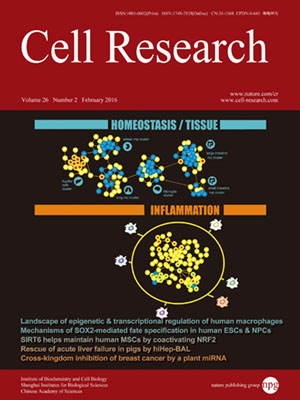
Volume 26, No 2, Feb 2016
ISSN: 1001-0602
EISSN: 1748-7838 2018
impact factor 17.848*
(Clarivate Analytics, 2019)
Volume 26 Issue 2, February 2016: 151-170 | Open Access
ORIGINAL ARTICLES
The transcriptional regulator network of human inflammatory macrophages is defined by open chromatin
Susanne V Schmidt1,*, Wolfgang Krebs1,*, Thomas Ulas1,*, Jia Xue1, Kevin Baßler1, Patrick Günther1, Anna-Lena Hardt1, Hartmut Schultze2, Jil Sander1, Kathrin Klee1, Heidi Theis1, Michael Kraut1, Marc Beyer1 and Joachim L Schultze1,3
1Genomics and Immunoregulation, LIMES-Institute, University of Bonn, 53115 Bonn, Germany
2Schultze Know How Beteiligungsgesellschaft mbH, Kirschblütenweg 2, 53639 Königswinter, Germany
3German Center for Neurodegenerative Diseases, 53175 Bonn, Germany
Correspondence: Joachim L Schultze,(j.schultze@uni-bonn.de)
Differentiation of inflammatory macrophages from monocytes is characterized by an orderly integration of epigenetic and transcriptional regulatory mechanisms guided by lineage-determining transcription factors such as PU.1. Further activation of macrophages leads to a stimulus- or microenvironment-specific signal integration with subsequent transcriptional control established by the action of tissue- or signal-associated transcription factors. Here, we assess four histone modifications during human macrophage activation and integrate this information with the gene expression data from 28 different macrophage activation conditions in combination with GM-CSF. Bioinformatically, for inflammatory macrophages we define a unique network of transcriptional and epigenetic regulators (TRs), which was characterized by accessible promoters independent of the activation signal. In contrast to the general accessibility of promoters of TRs, mRNA expression of central TRs belonging to the TR network displayed stimulus-specific expression patterns, indicating a second level of transcriptional regulation beyond epigenetic chromatin changes. In contrast, stringent integration of epigenetic and transcriptional regulation was observed in networks of TRs established from somatic tissues and tissue macrophages. In these networks, clusters of TRs with permissive histone marks were associated with high gene expression whereas clusters with repressive chromatin marks were associated with absent gene expression. Collectively, these results support that macrophage activation during inflammation in contrast to lineage determination is mainly regulated transcriptionally by a pre-defined TR network.
10.1038/cr.2016.1
FULL TEXT | PDF
Browse 1943


